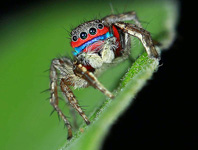Abstract
The records of the jumping plant-lice previously published under Carsidara shikokuensis (Miyatake, 1981) from Japan and C. marginalis Walker, 1869 from Korea are critically reviewed. It is concluded that both refer to the same species that is associated with Firmiana simplex (L.) W.Wight (Malvaceae). Carsidara shikokuensis shows no relevant morphological differences to C. limbata (Enderlein, 1926), and the two are synonymised: Carsidara limbata (Enderlein, 1926) = Carsidara shikokuensis (Miyatake, 1981) syn. nov. A record of C. marginalis from Korea is a misidentification of C. limbata. The latter is diagnosed and illustrated and differences to the former are discussed. The immatures of C. limbata are free-living on the leaves of Firmiana simplex and particularly the older instars secrete large amounts of flocculent wax and honeydew. Information on its potential usage as biological control agent of invasive Firmiana simplex in North America is briefly discussed.
References
Brown, R.G. & Hodkinson, I.D. (1988) Taxonomy and ecology of the jumping plant-lice of Panama (Homoptera: Psylloidea). Entomonograph. 9. E.J. Brill, Leiden, Netherlands, 304 pp.
Burckhardt, D., Ouvrard, D., Queiroz, D.L. & Percy, D. (2014) Psyllid host-plants (Hemiptera: Psylloidea): resolving a semantic problem. Florida Entomologist, 97 (1), 242−246.
http://dx.doi.org/10.1653/024.097.0132Enderlein, G. (1926) Psyllidologica VIII. Entomologische Mitteilungen, 15, 397−401.
Hodkinson, I.D. (1986) The psyllids (Homoptera: Psylloidea) of the Oriental zoogeographical region: an annotated check-list. Journal of Natural History, 20, 299−357.
http://dx.doi.org/10.1080/00222938600770251Hollis, D. (1987) A review of the Malvales-feeding psyllid family Carsidaridae (Homoptera). Bulletin of the British Museum (Natural History) Entomology, 56, 87−127.
Hollis, D. (2004) Australian Psylloidea. Jumping plantlice and lerp insects. Australian Biological Resources Study, Canberra, Australia, 216 pp.
Kwon, Y.J. & Huh, E.Y. (1998) Insects life in Korea II. Korea University Korean Entomological Institute, South Korea, 224 pp.
Li, F. (2011) Psyllidomorpha of China (Insecta: Hemiptera). Science Press, Beijing, China, i−xli, 1976 pp.
Miller, J.H., Chambliss, E.B. & Loewenstein, N.J. (2010) A Field Guide for the Identification of Invasive Plants in Southern Forests Gen. Tech. Rep. SRS–119. Asheville, NC, US. Department of Agriculture, Forest Service, Southern Research Station, 126 pp.
Miyatake, Y. (1981) Discovery of the tropical psyllid Thysanogyna minor from Japan, with description of a new subspecies (Hemiptera: Psyllidae). Bulletin of the Osaka Museum of Natural History, 35, 37−41.
Miyatake, Y. & Inoue, H. (2016) New distributional records of Carsidara shikokuensis (Miyatake, 1981) from Honshu and Kyushu, Japan (Sternorrhyncha, Psylloidea, Carsidaridae). Rostria, 59, 21−24.
Ossiannilsson, F. (1992) The Psylloidea (Homoptera) of Fennoscandia and Denmark. Fauna Entomologica Scandinavica 26. E.J. Brill, Leiden, Netherlands, 346 pp.
Ouvrard, D. (2016) Psyllist - The World Psylloidea Database. http://www.hemiptera-databases.com/psyllist - searched on 7 July 2016
http://dx.doi.org/10.5519/0029634Ouvrard, D., Chalise, P. & Percy, D.M. (2015) Host-plant leaps versus host-plant shuffle: a global survey reveals contrasting patterns in an oligophagous insect group (Hemiptera, Psylloidea). Systematics and Biodiversity, 13 (5), 434–454.
http://dx.doi.org/10.1080/14772000.2015.1046969Rawlins, K.A., Moorhead, D.J. & Bargeron, C.T. (2013) A homeowner’s guide to preventing the introduction and spread of invasive species: how you can make a difference. The University of Georgia, Center for Invasive Species and Ecosystem Health, Tifton GA. BW-2013-01. 36 pp.
Siebenthaler, J. (2016) Chinese parasol isn’t the cuddly green garden friend we’d like it to be. Here’s why it must be destroyed – and how to get started. Avaliable from: http://www.siebenthalercreative.com/acc/chineseparasol/#links (Acessed 8 July 2016)
Walker, F. (1869) Catalogue of the Homopterous insects collected in the Indian Archipelago by Mr. Wallace, A.R., with descriptions of new species (2nd part). Journal of the Linnean Society (Zoology), 10, 276−330.
http://dx.doi.org/10.1111/j.1096-3642.1869.tb00663.xYana, W., Mveyo Ndankeu, Y.P., Dzokou, V.J. & Tamesse, J.L. (2015) Jumping plant lice of the family Carsidaridae (Hemiptera: Psylloidea) from Cameroon: taxonomic, faunisitic, phenology and host plants. Journal of Biodiversity and Environmental Science, 6 (6), 1−20.

